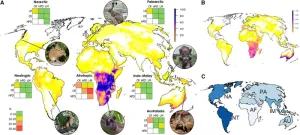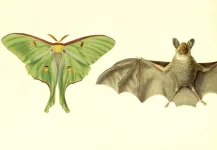(Press-News.org) Most conservation efforts are reactive. Typically, a species must reach threatened status before action is taken to prevent extinction, such as establishing protected areas. A new study published in the journal Current Biology on April 10 shows that we can use existing conservation data to predict which currently unthreatened species could become threatened and take proactive action to prevent their decline before it is too late.
“Conservation funding is really limited,” says lead author Marcel Cardillo (@MarcelCardillo) of Australian National University. “Ideally, what we need is some way of anticipating species that may not be threatened at the moment but have a high chance of becoming threatened in the future. Prevention is better than cure.”
To predict “over-the-horizon” extinction risk, Cardillo and colleagues looked at three aspects of global change—climate change, human population growth, and the rate of change in land use—together with intrinsic biological features that could make some species more vulnerable. The team predicts that up to 20% of land mammals will have a combination of two or more of these risk factors by the year 2100.
“Globally, the percentage of terrestrial mammal species that our models predict will have at least one of the four future risk factors by 2100 ranges from 40% under a middle-of-the-road emissions scenario with broad species dispersal to 58% under a fossil-fueled development scenario with no dispersal,” say the authors.
“There’s a congruence of multiple future risk factors in Sub-Saharan African and southeastern Australia: climate change (which is expected to be particularly severe in Africa), human population growth, and changes in land use,” says Cardillo. “And there are a lot of large mammal species that are likely to be more sensitive to these things. It’s pretty much the perfect storm.”
Larger mammals in particular, like elephants, rhinos, giraffes, and kangaroos, are often more susceptible to population decline since their reproductive patterns influence how quickly their populations can bounce back from disturbances. Compared to smaller mammals, such as rodents, which reproduce quickly and in larger numbers, bigger mammals, such as elephants, have long gestational periods and produce fewer offspring at a time.
“Traditionally, conservation has relied heavily on declaring protected areas,” says Cardillo. “The basic idea is that you remove or mitigate what is causing the species to become threatened.”
“But increasingly, it's being recognized that that's very much a Western view of conservation because it dictates separating people from nature,” says Cardillo. “It's a sort of view of nature where humans don't play a role, and that's something that doesn't sit well with a lot of cultures in many parts of the world.”
In preventing animal extinction, the researchers say we must also be aware of how conservation impacts Indigenous communities. Sub-Saharan Africa is home to many Indigenous populations, and Western ideas of conservation, although well-intended, may have negative impacts.
Australia has already begun tackling this issue by establishing Indigenous Protected Areas (IPAs), which are owned by Indigenous peoples and operate with the help of rangers from local communities. In these regions, humans and animals can coexist, as established through collaboration between governments and private landowners outside of these protected areas.
“There’s an important part to play for broad-scale modeling studies because they can provide a broad framework and context for planning,” says Cardillo. “But science is only a very small part of the mix. We hope our model acts as a catalyst for bringing about some kind of change in the outlook for conservation.”
###
Current Biology, Cardillo et al. “Priorities for conserving the world’s terrestrial mammals based on over-the-horizon extinction risk” https://www.cell.com/current-biology/fulltext/S0960-9822(23)00236-1
Current Biology (@CurrentBiology), published by Cell Press, is a bimonthly journal that features papers across all areas of biology. Current Biology strives to foster communication across fields of biology, both by publishing important findings of general interest and through highly accessible front matter for non-specialists. Visit http://www.cell.com/current-biology. To receive Cell Press media alerts, contact press@cell.com.
END
Elephants like to eat bananas, but they don’t usually peel them first in the way humans do. A new report in the journal Current Biology on April 10, however, shows that one very special Asian elephant named Pang Pha picked up banana peeling all on her own while living at the Berlin Zoo. She reserves it for yellow-brown bananas, first breaking the banana before shaking out and collecting the pulp, leaving the thick peel behind.
The female elephant most likely learned the unusual peeling behavior ...
About The Study: In this survey study of 9,400 adults ages 18 to 64, a higher rate of respondents with self-reported post–COVID-19 condition (PCC; also known as long COVID) did not obtain needed health care in the past year because of cost compared with adults without PCC. Adults with PCC were also more likely to have unmet needs because of difficulties getting timely appointments or health plan authorization, among other challenges with health care institutions or health insurance. These findings suggest that improved health care access for adults with PCC may require developing clinical protocols and addressing insurance-related barriers.
Authors: Michael ...
About The Study: The largest increase in children’s recreational screen time during the pandemic was on weekdays, especially at the outset of the pandemic when schools were closed; this increase was greater than expected for age-related growth. Change in weekend screen time during the pandemic was not significant compared with weekday screen time. Once in-person school resumed, weekday screen time decreased versus that during the COVID-1 wave (spring 2020), although it remained consistently higher than pre-pandemic estimates and age-related expectations.
Authors: Sheri Madigan, Ph.D., of the University of Calgary in Calgary, Canada, is the corresponding ...
Nearly 20 percent of today’s electricity in the United States comes from nuclear power. The U.S. has the largest nuclear fleet in the world, with 92 reactors scattered around the country. Many of these power plants have run for more than half a century and are approaching the end of their expected lifetimes.
Policymakers are debating whether to retire the aging reactors or reinforce their structures to continue producing nuclear energy, which many consider a low-carbon alternative to climate-warming coal, oil, and natural gas.
Now, MIT researchers say there’s another factor to consider in weighing the future of nuclear power: ...
AURORA, Colo. (April 10, 2023) – Involuntary displacement of people experiencing homelessness will likely lead to a substantial increase in morbidity and mortality over a 10-year period.
In a study, published today in the Journal of the American Medical Association (JAMA), researchers say practices such as encampment sweeps, bans, move-along-orders and cleanups that forcibly relocate individuals away from essential services will lead to substantial increases in overdose deaths, life threatening infections and hospitalizations.
In coordination with the National Healthcare for Homeless Council, the Center for Disease Control and Prevention (CDC) and the National Foundation ...
Throughout a woman's reproductive life, the endometrium, the mucous membrane lining the uterus, goes through cyclical remodeling. It thickens during the menstrual cycle in preparation for embryo implantation, and it is shed during menstruation when there is no fertilization.
Researchers at Baylor College of Medicine and collaborating institutions are investigating little-known factors directing uterine remodeling to advance the understanding of this process and provide new insights into fertility-associated gynecological conditions. They report today in the journal Developmental ...
An accretion disk is a colossal whirlpool of gas and dust that gathers around a black hole or a neutron star like cotton candy as it pulls in material from a nearby star. As the disk spins, it whips up powerful winds that push and pull on the sprawling, rotating plasma. These massive outflows can affect the surroundings of black holes by heating and blowing away the gas and dust around them.
At immense scales, “disk winds” can offer clues to how supermassive black holes shape entire galaxies. Astronomers have observed signs of disk winds in many systems, ...
About The Study: This simulation modeling study of 23 U.S. cities projects that involuntary displacement of people experiencing homelessness who inject drugs may yield substantial increases in morbidity and mortality over a 10-year period. Involuntary displacement is estimated to worsen overdose and hospitalizations, decrease initiations of medications for opioid use disorder, and contribute to deaths. These findings have implications for the practice of involuntary displacement, as well as policies such as access to housing and supportive services, that could mitigate these harms.
Authors: Joshua A. Barocas, M.D., ...
For more than 100 million Americans who are obese, bariatric surgery may reverse complications related to diabetes, including regenerating damaged nerves, a Michigan Medicine study shows.
A research team led by the University of Michigan Health Department of Neurology followed more than 120 patients who underwent bariatric surgery for obesity over two years after the procedure. They found that all metabolic risk factors for developing diabetes, such as high glucose and lipid levels, improved outside of blood pressure and total cholesterol, according to results published in Diabetologia.
Investigators ...
In a pair of complementary studies, researchers took a close look at Luna moth (Actias luna) tails through the eyes of birds and female moths to test the tails’ role in predation and sexual selection. Scientists have known for about a decade that Luna moths — and other related silkmoths — use their long, trailing tails to misdirect bat attacks.
“They have projections off the back of the hindwing that end in twisted, cupped paddles,” said Juliette Rubin, a doctoral student at the Florida Museum ...




